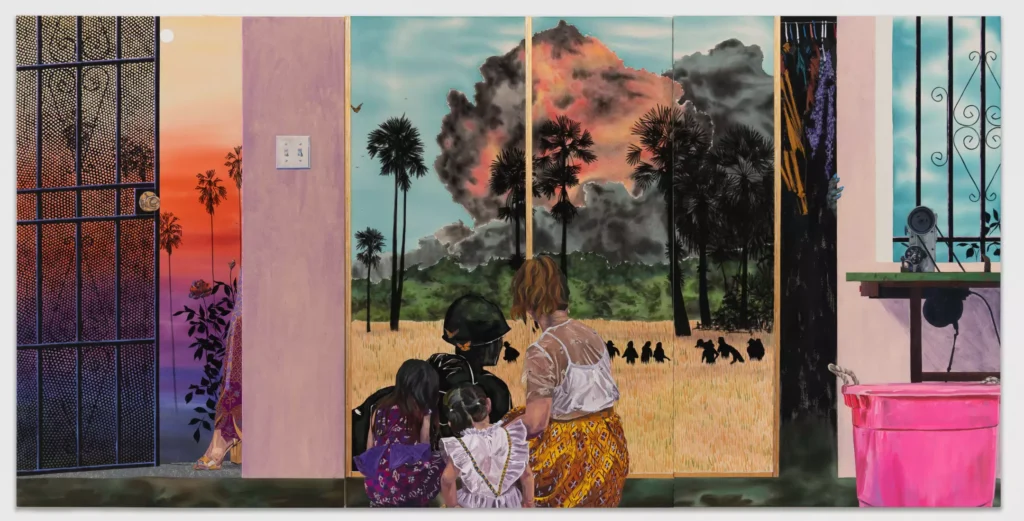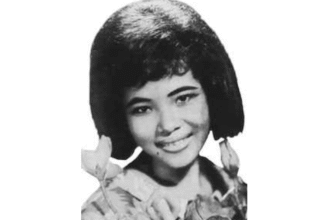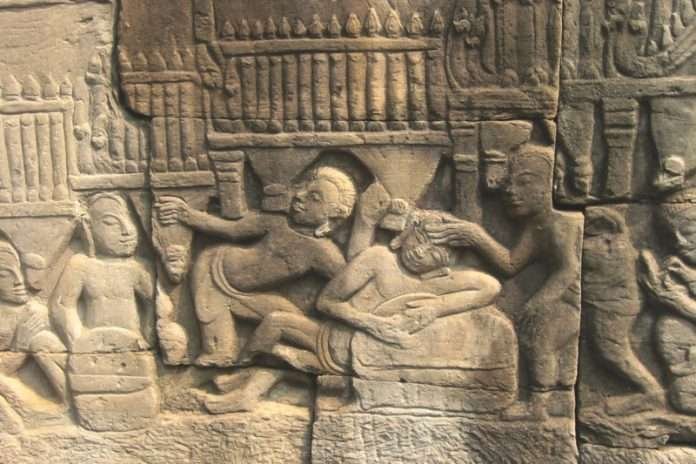In the heart of Long Beach, a city pulsating with diverse stories and cultures, Tidawhitney Lek, a gifted painter born and raised in this vibrant community, is capturing the surrealism of the Cambodian American experience with an unparalleled artistic flair. Through her unique use of double exposure, Lek weaves a visual tapestry that transcends time, blending the ghosts of the past with the present in a mesmerizing dance of colors and emotions.
At first glance, Lek’s paintings beckon you into intimate domestic scenes—women picnicking, figures dozing on sofas, and lush gardens. Yet, a closer inspection reveals a subtle disquiet, an unsettling undercurrent that challenges the viewer to question the narratives unfolding on the canvas. It is in this tension between the familiar and the disconcerting that Lek’s genius shines.
One distinctive feature in Lek’s work is the enigmatic hands that slink around doorways, sofas, and emerge from unexpected places. These hands, whether green or human shades of brown, adorned with glittery manicures, add an air of mystery to her compositions. When asked about their significance, Lek smiles and replies, “Friend or foe? That’s the idea.” It is this intentional ambiguity that draws viewers deeper into the narratives, prompting them to contemplate the dual nature of existence.

Lek’s magnum opus, “Refuge,” a three-panel painting exhibited at the Hammer Museum’s biennial, is a testament to her ability to blend the personal with the universal. Depicting three girls reacting to the Cambodian countryside’s bombardment in the 1970s, the painting unfolds as a visual paradox. Initially appearing as if the girls are huddled behind a soldier in a rice paddy, a second look reveals a different reality. The explosion is on the surface of a closet door in a mundane apartment, with a gnarled, green claw emerging like a ghost from the past. Inspired by her father’s experiences during the Khmer Rouge’s regime, “Refuge” is a haunting masterpiece that transcends time and place.
Lek’s canvases are a riot of rich colors, capturing the essence of Los Angeles sunsets and the shimmering beauty of traditional Cambodian attire, the sampot. Yet, beneath this visual splendor lies a profound exploration of real and cinematic horrors. Diana Nawi, co-curator of the “Acts of Living” exhibit, notes that Lek’s work contains humor but is also deeply connected to the realities of violence.
In her sunny studio above the Flower District, Lek welcomes visitors with strawberries and freshly brewed tea. Surrounded by new paintings set to feature in her solo show, “Living Spaces,” at the Long Beach Museum of Art, she reflects on her journey. Born to Cambodian refugee parents who survived the Khmer Rouge’s atrocities, Lek acknowledges the significance of her art as a reflection of her own narrative and a tribute to the resilience of her community.
Lek’s artistic journey, marked by a period of searching for the right visual language, has culminated in a style that is uniquely hers. Her paintings, she asserts, are her diaries—a personal conversation with herself about the past, present, and future. From a childhood where art was considered impractical to becoming a prominent figure in the contemporary art scene, Lek’s story resonates with perseverance and determination.

As the first generation of her immigrant family, Lek faced financial challenges growing up. Her parents, survivors of the Khmer Rouge, instilled the importance of practicality. Yet, against all odds, Lek pursued her passion for art. A turning point came during a trip to New York City in 2014, where exposure to the contemporary art scene ignited a fire within her.
Lek’s evolution as an artist took her from abstraction to figurative work, a journey that led her to paint her family and confront the complexities of her identity. Through her canvases, she found a medium to engage in conversations about her family’s history, particularly her father’s experiences during the fall of the Khmer Rouge.
Today, as Lek’s paintings garner attention in prestigious exhibitions and biennials, she remains grounded in her purpose. Her success isn’t merely measured by institutional approval but by the connections forged with her community. Messages of encouragement from fellow Cambodian Americans affirm that she is not just telling her story but representing the collective experiences of a resilient community.
In the ever-evolving landscape of contemporary art, Tidawhitney Lek stands as a testament to the power of storytelling through paint and canvas. Her art transcends cultural boundaries, inviting viewers to explore the depths of their own narratives while celebrating the indomitable spirit of the Cambodian American experience. In Lek’s vibrant strokes, we find not just a painter but a storyteller, weaving tales of resilience, identity, and the eternal dance between past and present.
Original Author: CAROLINA A. MIRANDA COLUMNIST, Los Angeles Times








